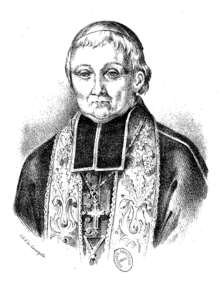Charles-Jean de La Motte-Vauvert
Charles-Jean de La Motte de Broons et de Vauvert (born August 13, 1782 in Saint Père-Marc-en-Poulet , † May 5, 1860 in Vannes ) was bishop of the French diocese of Vannes from 1827 to 1860 and one of the most important exponents the 19th century Catholic restoration in Brittany .
Life
Charles-Jean de La Motte-Vauvert was born in 1782 as the offspring of an old noble family at Launay Castle near Saint-Père in Brittany. His father was an officer in the French Navy. In the course of the French Revolution , Charles-Jean emigrated with his parents, first to Belgium, then to Hagen . In 1796 he joined the Prussian army and was trained as an artillery officer. Returned to France in 1806, he gave up his military career and entered the Rennes seminary in 1809 . He was ordained a priest in 1812. He then worked as a mathematics teacher at the small seminary in Rennes, as well as a clergyman at Saint-Germain ibid. And later canon at the cathedral.
With a royal decree of July 4, 1827 appointed Bishop of Vannes, he initially refused to accept the appointment, but finally accepted at the urging of his bishop and the papal nuncio and was on September 17, 1827 by Pope Leo XII. preconized and consecrated on October 28, 1827 by Archbishop Quélen in the Carmelite Church on Rue de Vaugirard in Paris.
On November 15, 1827, Mgr de La Motte took possession of his diocese, which he was to lead with great zeal for 33 years - until his death in 1860; He allowed himself a short absence only twice: in 1849 he took part in the Provincial Council in Tours and in 1859 in the celebrations for the elevation of the diocese of Rennes to the status of a metropolitan diocese .
Despite the expulsion of the Jesuits from the diocese in 1829, Bishop de La Motte received the small seminary in Sainte-Anne-d'Auray and promoted the settlement of the school brothers of Ploërmel in Ploërmel and Malestroit. After the death of the superior in 1833 - as in Sainte-Anne - he also replaced the Lazarists at the Major Seminary in Vannes with diocesan priests, but at the same time encouraged and promoted the establishment and establishment of other religious orders in the diocese: in 1834 the establishment of the daughters of Jesus ( Filles de Jésus ) in Bignan , in 1836 the Ursulines in Faouët and in 1841 the settlement of the Cistercians of the strict observance (" Trappists ") in Timadeuc .
In 1850 he established the College of St. Franz-Xaver in Vannes; other schools emerged in Hennebont , Gourin , Ploërmel and Sarzeau . His commitment to the school system finally led to the return of the Jesuits and the sisters from the retreat in 1845, as well as the settlement of the Picpus Fathers in Sarzeau and the Fathers of the Holy Spirit in Langonnet . The connection to "his" social and charitable works is probably also the reason why in May 1835 he turned down promotion to Archbishop of Aix . On January 1, 1850, Bishop de La Motte introduced the Roman liturgy in his diocese; In 1858 he received Emperor Napoleon III. in Sainte-Anne.
Mgr de La Motte died on May 5, 1860 and was buried at his own request in the part of the public cemetery reserved for the priests, where a neo-Gothic mausoleum was later built according to plans by the diocesan architect Marius Charier (1812–1890).
literature
- Jean-Marie Le Joubioux: Notice biographique sur Mgr de La Motte de Broons et de Vauvert, évêque de Vannes. JM Galles, Vannes 1861
- L'Épiscopat français: Depuis le Concordat jusqu'à la Séparation (1802-1905). Librairie de Saints-Pères, Paris 1907
- Mayeur, Jean-Marie; Hilaires, Yves-Marie: Dictionnaire du monde religieux dans la France contemporaine. Beauchesne, Paris 1985–1990.
Web links
- Mausolée de Charles de la Motte de Broons et de Vauvert (pictures of the mausoleum of Bishop de La Mottes in Vannes)
| personal data | |
|---|---|
| SURNAME | La Motte-Vauvert, Charles-Jean de |
| ALTERNATIVE NAMES | La Motte de Broons et de Vauvert, Charles-Jean de (full name) |
| BRIEF DESCRIPTION | French bishop |
| DATE OF BIRTH | August 13, 1782 |
| PLACE OF BIRTH | Saint Pere-Marc-en-Poulet |
| DATE OF DEATH | May 5, 1860 |
| Place of death | Vannes |
